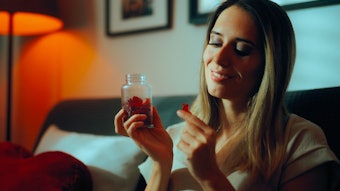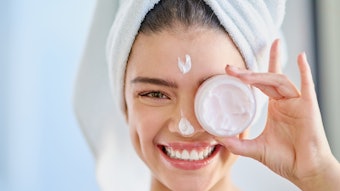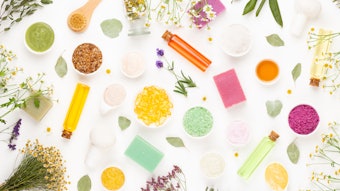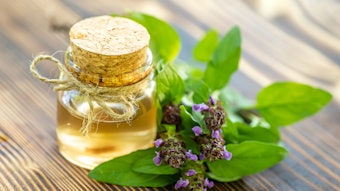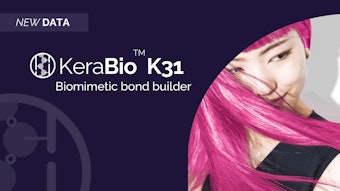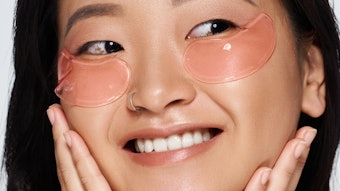Biologically, carotenoids are a significant group of organic pigments with more than 700 members. They are found widely throughout nature but are synthesized only by plants, algae, fungi and bacteria, where they aid in the absorption of light and capture excessive energy, neutralizing tissue-damaging free radicals.1 Chemically, carotenoids are isoprenoid, C-40 molecules that are either linear or cyclized at one or both ends of the molecule. The chemical structure determines their physico-chemical properties and biological activity.
Log in to view the full article
Biologically, carotenoids are a significant group of organic pigments with more than 700 members. They are found widely throughout nature but are synthesized only by plants, algae, fungi and bacteria, where they aid in the absorption of light and capture excessive energy, neutralizing tissue-damaging free radicals.1 Chemically, carotenoids are isoprenoid, C-40 molecules that are either linear or cyclized at one or both ends of the molecule. The chemical structure determines their physico-chemical properties and biological activity.
Carotenoids, specifically β-carotene and lycopene, were used as a treatment against photosensitization as early as 1964.2 Since then, a vast number of studies have shown that carotenoids act as antioxidants, anti-inflammatories and antimutagenic agents. These materials also are believed to potentially inhibit certain cardiovascular diseases and cancers. In addition, many carotenoids show beneficial immunological effects. Thus, these molecules are of interest for protective applications against premature aging and age-related disorders resulting from oxidative damage and stress.
Unfortunately, most carotenoids are sensitive to light, a property that considerably limits their use and shortens the shelf life of products that contain them.3 In addition, most carotenoids have a distinctive visible color that is undesirable in most cosmetic and some food applications. In contrast to other carotenoids, however, phytoene and phytofluene (P&P) lack visible color and absorb light in the ultraviolet (UV) range. They are also precursors in the bio-synthetic pathway of other carotenoids (see Figure 1).
Phytoene has been shown to act as an anticarcinogen in mouse skin cancer models4 and may play a role in cell-to-cell communication, as some studies with phytoene-producing transgenic mice have suggested.5 In addition, dietary P&P accumulate in human skin,6 offering protection by acting as UV absorbers, antioxidants and anti-inflammatory agents, suggesting they could play a protective role in beauty and skin applications.
Bioavailability and Tissue Distribution
Dietary carotenoids are found in most human tissues including the blood and skin.1, 7–11 The distribution of carotenoids throughout the human body is not uniform; for example, higher concentrations are found in the skin, compared with the lungs, plasma or lymphocytes. In addition, P&P accumulate in greater amounts than other carotenoids.9 Interestingly, the carotenoid content found within the human body also is notably greater than the content found in foods containing the molecule.12
UV Protection
UV radiation generates reactive oxygen species (ROS) and free radicals, which lead to DNA damage, lipid peroxidation, inflammation, collagen degradation and more, resulting in premature skin aging and potential skin cancer. UV irradiation causes DNA damage in two primary ways:
1. UVB damages DNA directly. Energy from sunlight causes an alteration in the chemical composition of the nucleotide bases, altering the molecular structure and disrupting DNA transcription; and
2. UVA causes damage indirectly. Here, the sunlight itself does not change the physical structure of DNA but rather triggers an array of molecules in the cell to break down in turn producing free radicals and ROS. These mutagenic agents can cause alterations in the physical structure of DNA.
P&Pa carotenoids can be employed to protect skin from UVA and UVB damage since phytoene has been shown to absorb UVB, while phytofluene absorbs UVA (see Figure 2). Together, they reduce UV transmission through partial absorption by reflecting or emitting light (see Figure 3). Mathews-Roth has demonstrated that carotenoids and phytoene specifically have photo-protective capabilities and can prevent UV-induced skin cancer.4, 13–15
Hydroxyl Radical Quenching
Hydroxyl radicals play a significant role in UV damage and are several levels of magnitude more reactive toward cellular constituents than superoxide radicals and hydrogen peroxide. This type of free radical can be formed from ∙O2- and H2O2 via the Harber Weiss reaction, which generates hydroxyl radicals from hydrogen peroxide and superoxide. The interaction of copper or iron with H2O2 also produces ∙OH, as first observed by Fenton.
These reactions are significant, because the constituents (∙O2-, H2O2 and H2O) are found within the body and on the skin, and can easily interact to generate damaging free radicals.16 Sunlight is a source for topical generation of hydroxyl radicals, as was demonstrated by Taira et al.17 This group suggested that skin exposed to sunlight may lead to hydroxyl radical generation and simultaneous lipid peroxidation.
P&P are some of the few antioxidants that show efficacy in quenching hydroxyl radicals (∙OH) by trapping and neutralizing them, as the DPPH assay in Figure 4 shows; however, they are
more then antioxidants, as their comparison with BHT shows in
Figure 5.18–20
Anti-inflammation and
DNA Damage
UVB light induces erythema formation. However, colorless carotenoids have been shown to significantly reduce the expression of inflammatory markers interleukin-6 and interleukin-12 in activated lymphocytes18 as well as reduce inflammation and potentially sun-damaged cells.18–22 Specifically, a 46% reduction in PGE-2 expression in interleukin-1-induced normal human fibroblasts has been observed.21 The anti-inflammatory activity of P&P carotenoids could thus reduce erythema formation.
Other studies have show a reduction of UV-induced erythema with a dietary intake of a combination containing the colorless carotenoids P&P.7, 23, 24 In most of these studies, researchers noted that added protection was likely due to the ability of P&P to absorb UV light, providing additional protection against UV-generated free radicals.3, 7, 24–27
Another detrimental effect of free radicals formed by UVA/UVB is collagen degradation, which leads to the premature skin aging expressed by wrinkles and loss of skin elasticity and shine. In vitro studies have shown that P&P are able to inhibit MMP-1 expression—which is involved in the breakdown of the extracellular matrix—at the low concentration of
15 µg/mL by 14%, a mild but significant effect. Therefore, P&P carotenoids could reduce the downstream collagen degradation effect of UV light.21
P&P also have demonstrated protective effects against DNA damage caused by hydroxyl radicals formed in vitro. This was measured by a reduction in fluorescence derived from biotinylated base pairs introduced to a reaction system following free radical damage to plasmid DNA. The DNA was protected by P&P, as shown by the change in fluorescence level indicated in Table 1, as well as following repair (not shown).
These findings are in accord with an intervention study conducted by Porinni et al.9 with carotenoids from natural tomato extract containing mostly lycopene, phytoene, phytofluene and β-carotene. This study showed modification of plasma and lymphocyte levels and improved antioxidant protection against DNA damage to lymphocytes with increasing values of plasma and lymphocyte carotenoid levels, especially in the case of phytoene.
Skin Brightening with P&P
Human skin tone varies between fair to dark brown. Skin type, according to the Fitzpatrick scale, ranges from I to VI with the higher numerals indicating darker, ethnic skin tones. Although these darker types are more resistant to sun irradiation, they are also at risk for skin cancer.
Differences in skin color are primarily determined by the amount of melanin present in melanocytes. Melanin production is stimulated by UVA light, leading to a tanning effect in skin. Aging, exposure to sun, hormonal abnormalities and various skin disorders increase the deposition of melanin pigment in skin, resulting in dark spots and freckles. These pigmented spots are undesired in many cultures and also considered unhealthy.
To eliminate pigmentation on skin or achieve a lighter skin tone, whitening or bleaching compositions are useful. Typical lightening agents in cosmetic formulations include kojic acid, arbutin, licorice extract and vitamin C. These are effective tyrosinase inhibitors and antioxidants but tend to be unstable since they are easily oxidized and degraded. Moreover, these compounds carry a higher risk for potential skin irritation and inflammation.
A combination of P&P has demonstrated efficacy on skin pigmentation by reducing the melanin content in skin cells.20 In addition, these natural carotenoids have not been shown to cause adverse effects when applied to skin or taken orally. An example of a skin-lightening formulation incorporating P&P carotenoids is shown in Formula 1.
P&P carotenoids in concentrations lower than known skin-lightening ingredients such as arbutin have in fact shown greater effects on melanin synthesis than such ingredients. For instance, P&P carotenoids have shown a 22% reduction in melanin content in B16 murine melanocytes at a concentration of 7.5 μM with no effect on cell viability, whereas arbutin, a known skin-lightening agent, has shown an effect on melanin synthesis without an inhibitory effect on cell growth at maximum concentrations of 50 μM.28 Although the lightening effect of P&P carotenoids has not been tested on ethnic skin, they have been formulated into ethnic products in Asia. These materials could in theory be used on ethnic skin to lighten, protect against UV damage and reduce inflammation.
Boosting Sunscreen SPF
Frequently, when sunscreens are exposed to sunlight, some of the light energy goes toward generating harmful free radicals and ROS. However, an active molecule that could quench or prevent free radical generation may stabilize the formulation and increase its safety and efficacy.
P&P carotenoids were tested in this capacity. Two sunscreen creams were prepared with 3.5% w/w octyl methoxycinnamate and 1% butyl methoxydibenzoylmethane. One sunscreen cream contained 5% P&P carotenoids from algae while the control did not contain the compounds. The in vitro SPF of both sunscreens was determined using a testing substrate that mimics the surface properties of human skinb. 2 mg/m2 was applied to the substrate and irradiated. The reflected light was measured by transmittance analyzerc. The Minimum Protection Factor (MPF) was obtained and SPF was calculated.
The P&P carotenoids were shown to provide stabilization and to reduce the generation of free radicals and damage derived from irradiation of TiO2
(see Figure 6); in addition, they boosted the SPF of a test sunscreen (see Table 2).
Conclusion
The colorless carotenoids P&P have been shown to protect the skin via oral and topical application against UV and oxidative damage that leads to premature aging and other disorders. This article summarizes the protective activities of colorless carotenoids against UV irradiation, free radicals and DNA damage as well as anti-inflammatory benefits, collagen production promotion and reduction of skin pigmentation. Finally, P&P carotenoids can efficiently stabilize sunscreens and boosts their sun protection capabilities.
References
1. A Bendich and JA Olson, Biological actions of carotenoids, FASEB J 3 1927–32 (1989)
2. MM Mathews, Protective effects of b-carotene lethal photosensitization by haematoporphyrin, Nature 203 1092 (1964)
3. NI Krinski, MM Mathews-Roth and RF Taylor (Eds), in: Carotenoids, Chemistry and Biology, New York, London: Platinum Press (1989)
4. MM Mathews-Roth, Antitumor activity of beta-carotene, canthaxanthin and phytoene, Oncology 39(1) 33–7 (1982)
5. Y Satomi, N Misawa, T Maoka and H Nishino, Production of phytoene, a carotenoid, and induction of connexin 26 in transgenic mice carrying the phytoene synthase gene crt, B. Biocem Biophy Res Comm 320 398–401 (2004)
6. F Khachik, L Carvalho, PS Bernstein, GJ Muire, DY Zhao and NB Katz. Chemistry, distribution, and metabolism of tomato carotenoids and their impact on human health, Exp Biol Med 227 845–851 (2002)
7. O Aust, W Stahl, H Sies, H Tronnier and U Heinrich, Supplementation with tomato-based products increases lycopene, phytofluene, and phytoene levels in human serum and protects against UV-light-induced erythema, Int J Vitam Nutr Res 75(1) 54–60 (2005)
8. IV Ermakov, MR Ermakova, W Gellermann and J Lademann, Noninvasive selective detection of lycopene and beta-carotene in human skin using Raman spectroscopy, J Biomed Opt 9(2) 332–8 (2004)
9. M Porrini, P Riso, A Brusamolino, C Berti, S Guarnieri and F Visioli, Daily intake of a formulated tomato drink affects carotenoid plasma and lymphocyte concentrations and improves cellular antioxidant protection, Brit J of Nutrition, 93(1) 93–99 (2005)
10. F Khachik, GR Beecher, MB Goli and WR Lusby, Separation, identification, and quantification of carotenoids in fruits, vegetables andhuman plasma by high performance liquid chromatography, Pure App Chem, 63(1) 71–80 (1991)
11. PD Fraser and PM Bramley, The biosynthesis and nutritional uses of carotenoids, Progress in Lipid Research 43 228–265 (2004)
12. TR Hata, TA Scholz, IV Ermakov, RW McClane, F Khachik, W Gellermann, LK Pershing, Non-invasive raman spectroscopic detection of carotenoids in human skin, J Invest Dermatol, 115(3) 441–8 (2000)
13. MM Mathews-Roth and NI Krinsky, Carotenoids affect development of UVB induced skin cancer, Photochem Photobiol 46(4) 507–9 (1987)
14. MM Mathews-Roth, Carotenoid functions in photoprotection and cancer prevention,J Environ Pathol Toxicol Oncol, 10(4–5) 181–92 (1990)
15. MM Mathews-Roth, Photoprotection by carotenoids, Fed Proc 46(5) 1890–3 (1987)
16. B Halliwell and JMC.Gutteridge, The chemistry of oxygen radicals and other oxygen-derived species. Free Radicals in Biology and Medicine, New York: Oxford University Press (1985) pp 20–64
17. J Taira, K Mimura, T Yoneya, A Hagi, A Murakami and K Makino, Hydroxyl radical formation by UV-irradiated epidermal cells, J Biochem 111(6) 693–5 (1992)
18. L Von Oppen-Bezalel, E Lerner, DG Kern,
B Fuller, E Soudant and A Shaish, IBR-CLC, Colorless Carotenoids: Phytoene and Phytofluene from Unicellular Algae–Applications in Cosmetics, Wellness and Nutrition, Fragrance J, 34 48–53 (2006)
19. L Von Oppen-Bezalel, Colorless Carotenoids, phytoene and phytofluene for the skin: For prevention of aging/photo-aging from inside and out, SÖFW, 7 (2007)
20. L Von Oppen-Bezalel, UVA, A main concern in sun damage: Protection from the inside and outside with phytoene, phytofluene, the colorless carotenoids and more, SÖFW, 11 (2007)
21. BB Fuller, DR Smith, AJ Howerton, D Kern, Anti-inflammatory effects of CoQ10 and colorless carotenoids, J Cos Derm 5(1) 30–38 (2006)
22. MM Mathews-Roth and MA Pathak, Phytoene as a protective agent against sunburn (>280 nm) radiation in guinea pigs, Photochem Photobiol, 21(4) 261–26 (1975)
23. JP Cesarini, L Michel, JM Maurette, H Adhoute and M Bejot, Immediate effects of UV radiation on the skin: Modification by an antioxidant complex containing carotenoids, Photodermatol Photoimmunol Photomed 19(4) 182–9 (2003)
24. Y Sharoni, Lycopene, skin cancer and UV exposure, in Conference notes: Examining the Health Benefits of Lycopene from Tomatoes, Washington, DC, conference convened by the Center for Food and Nutrition Policy at Virginia Tech (Apr 1–2, 2003)
25. W Stahl, U Heinrich, S Wiseman, O Eichler, H Sies and H Tronnier, Dietary tomato paste protects against UV-induced erythema in humans, J Nutr 131 1449–1451 (2001)
26. J Lee, S Jiang, N Levine and RR Watson, Carotenoid supplementation reduces erythema in human skin after simulated solar radiation exposure, Proc Soc Exp Biol Med 223 170–174 (2000)
27. H Sies and W Stahl. Carotenoids and UV protection, Photochem Photobiol Sci 3(8) 749–52 (2004)
28. S Akiu, Y Suzuki, T Asahara, Y Fujinuma and M Fukuda, Inhibitory effect of arbutin on melanogenesis—Biochemical study using cultured B16 melanoma cells, Nippon Hifuka Gakkai Zasshi, 101(6) 609–13 (1999)

